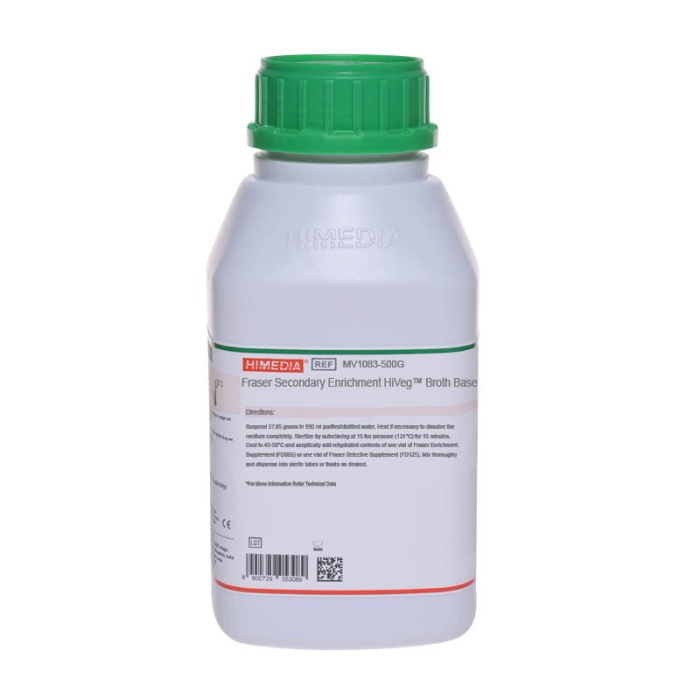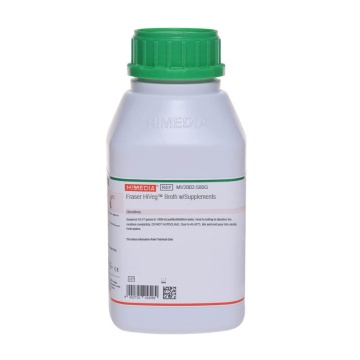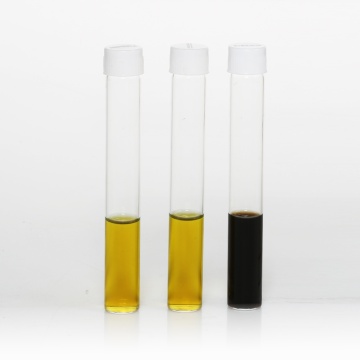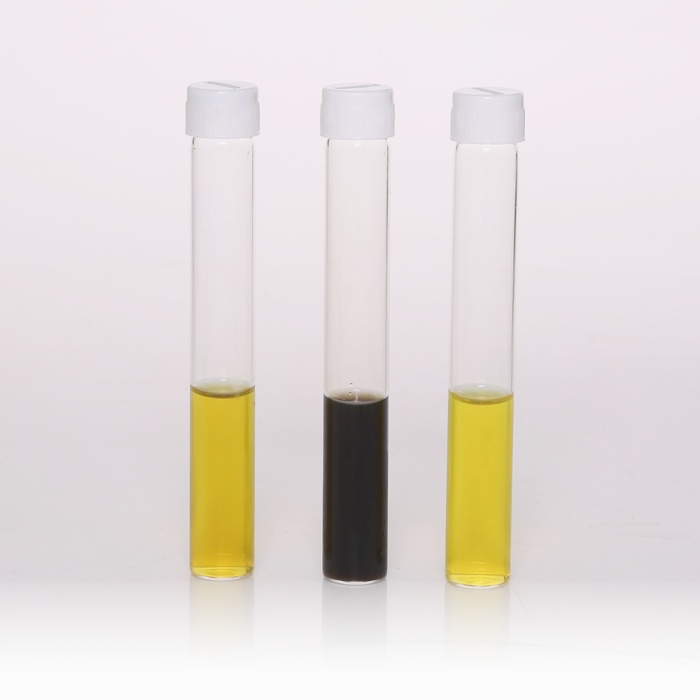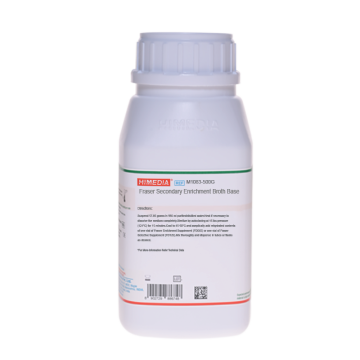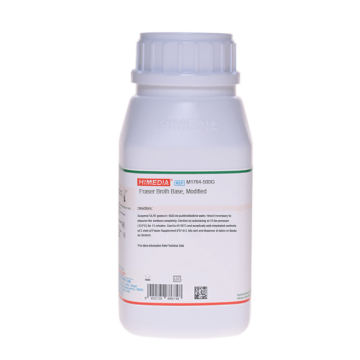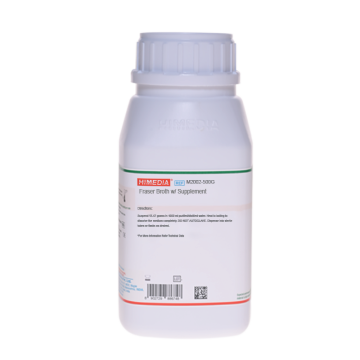 Your enquiry has been submitted
Your enquiry has been submitted
Fraser Broth Base
Intended use
Recommended, recommended as a primary as well as secondary enrichment medium, for the isolation and enumeration of Listeria monocytogenes from food and animal feeds. The composition and performance criteria of this media is as per the specification laid down in ISO 11290-1:2017, ISO 11290-2:2017 and ISO 11133:2014 (E) /Amd.: 2020.
Composition**
ISO 11290 Specification - Half Fraser & Fraser
| Ingredients | g/L |
|---|---|
| Enzymatic digest of animal tissues | 5.000 |
| Enzymatic digest of casein | 5.000 |
| Yeast extract | 5.000 |
| Meat extract | 5.000 |
| Sodium chloride | 20.000 |
| Disodium hydrogen phosphate dihydrate | 12.000 |
| Potassium dihydrogen phosphate | 1.350 |
| Esculin | 1.000 |
| Lithium chloride | 3.000 |
| Final pH (at 25°C) | 7.2±0.2 |
Fraser Broth : Half Fraser & Fraser broth
| Ingredients | g/L |
|---|---|
| Peptone # | 5.000 |
| Tryptone $ | 5.000 |
| Yeast extract | 5.000 |
| HM extract ## | 5.000 |
| Sodium chloride | 20.000 |
| Disodium hydrogen phosphate dihydrate | 12.000 |
| Potassium dihydrogen phosphate | 1.350 |
| Esculin | 1.000 |
| Lithium chloride | 3.000 |
| Final pH (at 25°C) | 7.2±0.2 |
Supplements to be added after autoclaving
| Half fraser g/L | Fraser g/L | Half fraser g/L | Fraser g/L | ||
|---|---|---|---|---|---|
| FD125I | 1 vial | 2 vials | |||
| Acriflavin hydrochloride | 0.0125 | 0.025 | Acriflavin hydrochloride | 0.0125 | 0.025 |
| Nalidixic acid, sodium salt | 0.01 | 0.02 | Nalidixic acid, sodium salt | 0.01 | 0.02 |
| FD141 | 2 vials | 2 vials | |||
| Ammonium Iron citrate | 0.5 | 0.50 | Ammonium Iron citrate | 0.5 | 0.50 |
**Formula adjusted, standardized to suit performance parameters
# - Equivalent to Enzymatic digest of animal tissues
$ - Equivalent to Enzymatic digest of casein
##- Equivalent to Meat extract
Directions
Suspend 54.92 gram (the equivalent weight of dehydrated medium per litre) in 1000 ml purified / distilled water. Heat if necessary to dissolve the medium completely. Sterilize by autoclaving at 15 lbs pressure (121°C) for 15 minutes. Cool to 45-50°C and aseptically add rehydrated contents of 1 vial of Fraser Selective Supplement (FD125I) and 2 vials of Fraser Supplement (FD141) to 1000 ml medium for primary enrichment or 1 vial of each to 500 ml medium for secondary enrichment. Mix well and dispense in tubes or flasks as desired.
Principle And Interpretation
Listeria species are widely distributed in the environment. They have been isolated from soil, decaying vegetable matter, silage, sewage, water, animal feed, fresh and frozen poultry, meats, raw milk, cheese and asymptomatic human and animal carriers (1). L.monocytogenes primarily causes meningitis, encephalitis or septicemia in humans (2,3). In pregnant women, L.monocytogenes often causes influenza like bacteremic illness that, if untreated, may leaded to ammionitis and infection of the fetus, resulting in abortion, still birth or premature birth. Contaminated foods are the primary vehicles of transmission (4). Fraser Broth Base is based on the formulation of Fraser and Sperber (5) is used for the detection of Listeria species in food products (6). Fraser Broth Base is formulated so as to provide optimum conditions for the growth of Listeria. This medium is recommended by ISO for primary and secondary enrichment of Listeria species (7,8,9).
Peptone, Tryptone, yeast extract, and HM extract make the media highly nutritive by providing essential nutrients including carbonaceous and nitrogenous substances. Phosphates maintain the buffering capacity of the medium. All Listeria species exhibit beta-glucosidase activity which is evident by the blackening of the media. Listeria species hydrolyze esculin (substituted glucoside) to glucose and esculetin. The latter combines with ferric ions of ferric ammonium citrate (FD141), resulting in the formation of 6-7 dihydroxycoumarin, a black brown complex. Ferric ammonium citrate also enhances the growth of L.monocytogenes (10). The high salt tolerance (of sodium chloride) of Listeria is used as means to inhibit the growth of Enterococci. Lithium chloride is also used to inhibit Enterococci, which also possess the ability to hydrolyze esculin. Growth of accompanying bacteria is largely inhibited by the addition of Nalidixic acid and Acriflavin hydrochloride (FD125I).
Type of specimen :
Food samples
Specimen Collection and Handling:
- Initial suspension
This broth is used as an dilution fluid for the preparation of initial suspension
25grams/25 ml of sample to 225 ml of the medium (M1327 + 1 vial of FD125I + 2 vials of FD141)
- Primary enrichment
The dilution prepared in Half Fraser broth is incubated at 30°C ± 1°C for 24-26 hours.
The preenriched sample after incubation can be stored at 5°C for a maximum of 72 hours before transfer to Fraser Broth (secondary enrichment)
- A black colouration can develop during incubation.
- Secondary Enrichment
0.1 ml of culture from primary enrichment is added to 10 ml of Fraser Broth (secondary enrichment). It is incubated at 37°C ± 1°C for 24 ± 2 hours.
Additional incubation of 24 hours for Listeria species other than L.monocytogenes is recommended to allow recovery of more species.
The sample from primary enrichment and secondary enrichment is then subcultured on HiCrome™ Listeria Ottaviani-Agosti Agar Base (M1540I) and on Listeria Oxford Medium Base (M1145) or Listeria Identification Agar Base (PALCAM) (M1064I). Incubate at 37 ± 1 °C for 24 ± 2 hours. Additional incubation at 37 ± 1 °C for 24 ± 2 hours is recommended for Listeria spp. other than L.monocytogenes for recovery of more species. (7,8)
Warning and Precautions :
Read the label before opening the container. Wear protective gloves/protective clothing/eye protection/ face protection. Follow good microbiological lab practices while handling specimens and culture. Standard precautions as per established guidelines should be followed while handling specimens. Safety guidelines may be referred in individual safety data sheets.
Limitations :
- Individual organisms differ in their growth requirement and may show variable growth patterns on the medium.
- Each lot of the medium has been tested for the organisms specified on the COA. It is recommended to users to validate the medium for any specific microorganism other than mentioned in the COA based on the user's unique requirement.
- Presence of L.monocytogenes is often masked by other Listeria species like L.inocua and L.ivanovii.
- Further subculture of organisms on selective media is required.
Performance and Evaluation
Performance of the medium is expected when used as per the direction on the label within theexpiry period when stored at recommended temperature.
Quality Control
Appearance Cream to yellow homogeneous free flowing powder
Colour and Clarity of prepared medium Basal medium: Yellow coloured clear solution with slight precipitate. After addition : Fluorescent yellow coloured clear solution with slight precipitate forms in tubes.
Reaction Reaction of 5.49% w/v aqueous solution at 25°C. pH : 7.2±0.2
pH 7.00-7.40
Cultural Response
Half Fraser (Primary Enrichment)
Productivity
Cultural characteristics observed on addition of FD125I and FD141 after an incubation at 30 ± 1°C for 25 ± 1 hour. Further subculture is carried out on M1540I at 37 ± 1°C for 48± 4 hours.
| Organism | Inoculum (CFU) | Growth | Esculin Hydrolysis | Recovery on M1540I* | Colour of colony on M1540I* |
|---|---|---|---|---|---|
| Listeria monocytogenes 1/2a ATCC 35152 (00109*) + | 50-100 | good-luxuriant | positive reaction, blackening of medium | >10 colonies | Blue green colonies w/ opaque halo |
| Escherichia coli ATCC 25922 (00013*) + | >=104 | ||||
| Enterococcus faecalis ATCC 29212 (00087*) | >=104 | ||||
| Listeria monocytogenes 1/2a ATCC 35152 (00109*) + | 50-100 | good-luxuriant | positive reaction, blackening of medium | >10 colonies | Blue green colonies w/ opaque halo |
| Escherichia coli ATCC 8739 (00012*) + | >=104 | ||||
| Enterococcus faecalis ATCC 19433 (00009*) | >=104 | ||||
| Listeria monocytogenes 4b ATCC 13932 (00021*) + | 50-100 | good-luxuriant | positive reaction, blackening of medium | >10 colonies | Blue green colonies w/ opaque halo |
| Escherichia coli ATCC 25922 (00013*) + | >=104 | ||||
| Enterococcus faecalis ATCC 29212 (00087*) | >=104 | ||||
| Listeria monocytogenes 4b ATCC 13932 (00021*)+ | 50-100 | good-luxuriant | positive reaction, blackening of medium | >10 colonies | Blue green colonies w/ opaque halo |
| Escherichia coli ATCC 8739 (00012*) + | >=104 | ||||
| Enterococcus faecalis ATCC 19433 (00009*) | >=104 |
Selectivity
Cultural characteristics observed on addition of FD125I and FD141 after an incubation at 30 ± 1°C for 25 ± 1 hour. Further subculture is carried on Tryptone Soya Agar (M290) after an incubation at 37 ± 1°C for 48± 4 hours.
| Organism | Inoculum (CFU) | Growth | Recovery on M290 |
|---|---|---|---|
| Escherichia coli ATCC 25922 (00013*) | >=104 | inhibited | 0 |
| Escherichia coli ATCC 8739 (00012*) | >=104 | inhibited | 0 |
| Enterococcus faecalis ATCC 29212 (00087*) | >=104 | none-poor | <100 colonies |
| Enterococcus faecalis ATCC 19433 (00009*) | >=104 | none-poor | <100 colonies |
Cultural Response
Fraser (Secondary Enrichment)
Productivity
Cultural characteristics observed on addition of FD125I and FD141 after an incubation at 37 ± 1°C for 24 ± 2 hours. Further subculture is carried out on M1540I at 37 ± 1°C for 48± 4 hours.
| Organism | Inoculum (CFU) | Growth | Esculin Hydrolysis | Recovery on M1540I* | Colour of colony on M1540I* |
|---|---|---|---|---|---|
| Listeria monocytogenes 1/2a ATCC 35152 (00109*) + | 50-100 | good-luxuriant | positive reaction, blackening of medium | >10 colonies | Blue green colonies w/ opaque halo |
| Escherichia coli ATCC 25922 (00013*) + | >=104 | ||||
| Enterococcus faecalis ATCC 29212 (00087*) | >=104 | ||||
| Listeria monocytogenes 1/2a ATCC 35152 (00109*) + | 50-100 | good-luxuriant | positive reaction, blackening of medium | >10 colonies | Blue green colonies w/ opaque halo |
| Escherichia coli ATCC 8739 (00012*) + | >=104 | ||||
| Enterococcus faecalis ATCC 19433 (00009*) | >=104 | ||||
| Listeria monocytogenes 4b ATCC 13932 (00021*) + | 50-100 | good-luxuriant | positive reaction, blackening of medium | >10 colonies | Blue green colonies w/ opaque halo |
| Escherichia coli ATCC 25922 (00013*) + | >=104 | ||||
| Enterococcus faecalis ATCC 29212 (00087*) | >=104 | ||||
| Listeria monocytogenes 4b ATCC 13932 (00021*) + | 50-100 | good-luxuriant | positive reaction, blackening of medium | >10 colonies | Blue green colonies w/ opaque halo |
| Escherichia coli ATCC 8739 (00012*) + | >=104 | ||||
| Enterococcus faecalis ATCC 19433 (00009*) | >=104 |
Selectivity
Cultural characteristics observed on addition of FD125I and FD141 after an incubation at 37 ± 1°C for 24 ± 2 hour. Further subculture is carried on Tryptone Soya Agar (M290) after an incubation at 37 ± 1°C for 48± 4 hours.
| Organism | Inoculum (CFU) | Growth | Recovery on M290 |
|---|---|---|---|
| Escherichia coli ATCC 25922 (00013*) | >=104 | inhibited | 0 |
| Escherichia coli ATCC 8739 (00012*) | >=104 | inhibited | 0 |
| Enterococcus faecalis ATCC 29212 (00087*) | >=104 | none-poor | <100 colonies |
| Enterococcus faecalis ATCC 19433 (00009*) | >=104 | none-poor | <100 colonies |
Storage and Shelf Life
Store between 10-30°C in a tightly closed container and prepared medium at 2-8°C. Use before expiry date on the label. On opening, product should be properly stored dry, after tightly capping the bottle inorder to prevent lump formation due to the hygroscopic nature of the product. Improper storage of the product may lead to lump formation. Store in dry ventilated area protected from extremes of temperature and sources of ignition Seal the container tightly after use.
Disposal
User must ensure safe disposal by autoclaving and/or incineration of used or unusable preparations of this product. Follow established laboratory procedures in disposing of infectious materials and material that comes into contact with sample must be decontaminated and disposed of in accordance with current laboratory techniques (1,4).
Reference
- Isenberg, H.D. Clinical Microbiology Procedures Handbook 2nd Edition.
- Nieman R. E., and Lorber B., 1980, Rev. Infect. Dis. 2: 207-2
- Schuchat A. B., Swaminathan and C. V. Broome, Clin. Microbiol., Rev. 4: 169-1
- Jorgensen, J.H., Pfaller, M.A., Carroll, K.C., Funke, G., Landry, M.L., Richter, S.S and Warnock., D.W. (2015) Manual of Clinical Microbiology, 11th Edition. Vol. 1.
- Fraser and Sperber, 1988, J. Food Prot., 51:762-76
- Salfinger Y., and Tortorello M.L., 2015, Compendium of Methods for the Microbiological Examination of Foods, 5th Ed., American Public Health Association, Washington, D.C.
- Microbiology of the food chain Horizontal method for the detection and enumeration of Listeria monocytogenes and of Listeria spp. Part 1, Detection method; ISO 11290-1:2017
- Microbiology of the food chain Horizontal method for the detection and enumeration of Listeria monocytogenes and of Listeria spp. - Part 2, Detection method; ISO 11290-2:2017
- Microbiology of food, animal feeding stuffs and water- Preparation, production, storage and performance testing of culture media, EN ISO 11133:2014 (E) /Amd.: 2020
- Cowart R. E. and Foster BG., 1985, J. Infect. Dis.; 151:17
| Product Name | Fraser Broth Base |
|---|---|
| SKU | M1327 |
| Product Type | Regular |
| Physical Form | Powder |
| Origin | Animal |
| Packaging type | HDPE |
| References | 1. Nieman R. E., and Lorber B., 1980, Rev. Infect. Dis. 2 : 207-227 |
| Customized Product Available | No |





